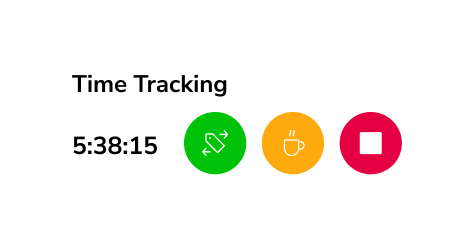5 Effective Ways to Leave Work on Time
When was the last time you left work on time? If that took you more than 10 minutes to answer, I’m guessing it’s been a pretty long time.
According to a 2021 Gallup survey, full-time employees work on average 44 hours per week, with 43% even putting in 45 hours or more each week. Meanwhile, a separate ADP Research Institute survey found that 71% of the respondents worked overtime at least once a week.
It’s clear that most of us struggle with leaving work on time. And whether it’s a nasty habit of overworking, succumbing to last-minute overtime requests, or just poor time management, it’s high time to re-evaluate your work-balance situation. Because let me tell you, overworking yourself may seem intuitive, but it’s actually counterproductive.
Excessive work and resulting stress can lead to various health issues, such as sleep problems, depression, increased alcohol consumption, diabetes, memory impairment, and heart disease. Not only are these detrimental to personal well-being, but they also negatively affect your work performance, manifesting as increased absenteeism and more mistakes at work. Plenty of credible bodies of research and studies support the negative effects of overwork, including ones by the National Library of Medicine and the World Health Organization.
So, if you really think about it, the short-term benefits of working those excessively long hours really aren’t worth the long-term consequences. You won’t only be harming yourself but the company you’re working for. Sarah Green Carmichael from the Harvard Business Review couldn’t have said it better:
“The story of overwork is literally a story of diminishing returns: keep overworking, and you’ll progressively work more stupidly on tasks that are increasingly meaningless.”
So I suggest you pause logging those extra hours and try applying these five strategies that can help you leave work on the dot while making the most of your time during working hours.

Photo by Andrea Piacquadio on Pexels
5 Effective Ways to Leave Work on Time
1. Create end-of-the-day goals
This is so important, but unfortunately, not a lot of people do it. If you’re not working towards anything for the day, you’re more likely to go with the flow and end your shift with a huge pile of work still at your desk.
By setting specific objectives for the work hours, you create a sense of purpose and direction. For instance, if you’re a project manager, your end-of-the-day goal could be to finalize the project timeline or send out progress updates to the team. Having these goals keeps you focused and provides a natural conclusion point for your workday.
When creating your end-of-the-day goals, it’s important to be realistic. Don’t try to plan more than you can accomplish. A shorter task list might seem counterintuitive, but if you typically plan over 10 tasks per day and usually complete only 5 or 6, planning just three tasks could help you finish them all. With fewer tasks, you’ll find it easier to concentrate, and when those three are done, you’ll have a sense of accomplishment. Even if you end up completing 5 or 6 tasks, your end-of-the-day goals are essentially achieved, giving you a better feeling as you leave work on time.
2. Prioritize and time your tasks
Now that your goals for the day are set, it’s time to outline and prioritize the tasks that will help you achieve them.
Prioritizing tasks is crucial to managing your workload efficiently. Begin by categorizing tasks based on urgency and importance. You will also need to set how much time you intend to spend on each one. When allocating time for each task, try to keep in mind Parkinson’s law:
“Work expands or contracts to fill the time available for it.”
In simpler terms, the amount of time you have to finish a task influences how long it will actually take. If you give yourself two hours, you’ll likely complete the work in that time. On the other hand, if you have the entire day, the task will end up taking the whole day. Without setting time limits, you risk spending excessive time on a single task, potentially derailing productivity.
This is important: don’t underestimate how long tasks will take. You need to be realistic. You might encounter hiccups or work distractions along the way, so it’s important to factor in some buffer time in your time limits to accommodate unexpected delays.
By assigning realistic time limits to activities, you create a structured framework that helps prevent overcommitting and ensures a more accurate assessment of your workload. Once you’ve set your time limits, the next step is to actually stick to them. A great way to do this is to use time tracking software or project time tracker. These nifty tools will help you accurately monitor how much time you spend to each task and provide valuable insights into your productivity patterns.
3. Schedule activities after work
If you have a medical appointment or a special event to go to after work, you’re more likely to be out of that door the moment your shift ends. It’s a general consensus that after-work activities urge us to actually leave work on time. So why not schedule after-work activities every day?
And no, I don’t mean you have to go to the doctor or attend special events every day! After work activities can also mean scheduling to go to the gym, meet up with friends, take a walk at the park, cook dinner by 7 pm, and so on. Plan events, hobbies, or personal commitments to give yourself a reason to leave on time. Knowing that you have specific engagements waiting for you can motivate you to complete tasks within the designated work hours. This enhances work-life balance and instills discipline in adhering to a set schedule.
Make sure to add these activities to your calendar and regard them as appointments you MUST be on time for. This sense of urgency will motivate you to get ready to leave work on the dot.
4. Give yourself 15-20 minutes to wrap up
If your shift ends at 5pm, don’t wait until 5pm to start wrapping up your work. This is a surefire way to keep you at the office longer than you should. Instead, allocate a dedicated period, preferably 15-20 minutes, at the end of your workday to wrap up tasks.
During this time, finalize any pending assignments, respond to urgent emails, and organize your workspace for the next day. Setting aside this buffer zone creates a natural endpoint for your work, signaling that it’s time to conclude your day. This practice not only ensures a smoother transition out of work mode but also aids in avoiding last-minute tasks that can extend your working hours.
5. Change the way you think about leaving work on time
Going out of the office door on time is nothing to feel guilty about. It doesn’t indicate a lack of commitment, laziness, or dislike for your colleagues. As long as you’ve achieved the goals you’ve set for the day, going home on time should be celebrated. It’s a sign that you’ve managed your time effectively.
To feel less guilty about leaving work on time, try to shift your perspective on leaving work by viewing it as a step toward personal well-being and a balanced life. Instead of thinking, “I’m leaving work now,” consider phrases like “I’m going home to spend time with my family and friends” or “I’m heading to the gym to be healthier.” This mental shift helps you recognize the value of leaving work on time to maintain a healthy lifestyle, fostering connections, and engaging in activities that contribute to your overall well-being.
Why You Need to Leave Work on Time
There are several compelling reasons that make leaving work on time necessary for maintaining your overall well-being. We’ve covered some of them in this article’s overview, but let’s take a deeper look at just how this simple decision can significantly impact various aspects of your life.
Overwork is not good for you or your company
The toll that prolonged working hours can take on your mental and physical health cannot be overstated. Research has consistently shown that extended periods of work-related stress and overwork can lead to serious health issues, including increased levels of stress and anxiety. The research findings from the World Health Organization also suggest that working 55 hours or more each week is linked to a 35% higher chance of experiencing a stroke and a 17% higher likelihood of death from ischemic heart disease compared to those working 35-40 hours per week. It’s a steep price to pay for sacrificing your well-being at the altar of work.
Aside from the negative effects on your health, overwork can also negatively affect your company. Many studies have shown that working long hours doesn’t necessarily lead to increased productivity. Instead, chronic overwork and the resulting stress and health problems can actually contribute to absenteeism, higher turnover, and rising health insurance costs for companies. And no matter how good you are at your job, when you’re fatigued and exhausted from working all those long hours, you won’t only be inefficient with your tasks, but you’ll be more likely to make mistakes too.
A 2021 Work and Well-being Survey by The American Psychological Association, which involved 1,501 U.S. adult workers, revealed that 79% of employees had experienced stress related to their work in the month preceding the survey. Almost 3 in 5 employees reported feeling the negative impacts of work-related stress. This included a lack of interest, motivation, or energy for 26% of respondents and a lack of effort at work for 19%.
The bottom line? Overwork not only jeopardizes your health but also seriously compromises your effectiveness in the workplace.
Leaving work on time enhances work-life balance
Ah, yes, work-life balance. Isn’t that what most, if not all of us, want to achieve? That’s why it’s become the subject of so many self-help books and seminars. And I’m no certified life coach or productivity guru, but I can tell you for certain that one of the steps you can take to get closer to the ever-elusive work-life balance is not spending all of your time at the office.
Leaving work on time provides a valuable opportunity to detach from professional duties and allocate quality time to activities that bring personal joy and fulfillment. Whether it’s socializing with friends, enjoying a leisurely stroll with your dog, or finally delving into that book patiently waiting on your shelf, these seemingly simple pleasures play a crucial role in recharging your mental and emotional batteries. This way, you can get back to work with a refreshed mindset and renewed motivation.
Leaving on time forces you to be disciplined
We all know discipline is important in personal and professional success. And even something as simple as setting yourself up to leave work on time every day can be a way to force yourself to be more disciplined with how you handle your time at work.
Let’s go back to what Parkinson’s law says: “Work will expand or contract to fill the time available for it.” If you keep procrastinating and stretching your work deadlines, you’re bound to extend your hours at the office at the end of the day. But if you set clear and non-negotiable deadlines for yourself, you’ll be forced to finish tasks and projects within the allotted time. By imposing a boundary on your work hours, you force yourself to be more disciplined, prioritize tasks, make efficient decisions, and avoid unnecessary procrastination.
Final Thoughts
There’s nothing wrong with working a few extra hours every once in a while, especially if you love doing your job. But if you find yourself spending more time at the office than necessary, feeling a diminishing sense of motivation, or experiencing persistent brain fog, then that may be your body telling you to take a step back and re-evaluate your work-life balance.
The evidence is clear: chronic overwork is not good for you or your company. So, do yourself and your company a favor by trying out the five strategies outlined in this guide. These will help you take control of your workday and finish what you need to do by the end of your shift. This, in turn, will allow you to leave the office on time so you can recharge and be at your optimal for the next workday. Cheers!


